Argentina
Landings
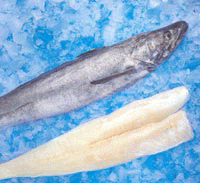
Argentinean landings of hake between January and November 2007 fell for all species compared to the same period in 2006. From 440 681 tonnes in 2006, total captures went down 17.6% and registered 363 046 tonnes in 2007. This trend was shown by all species. The one with the strongest reduction was hoki (Macruronus magellanicus), which registered landings of 86 472.5 tonnes, 24.2% lower that in the same period in 2006. This species was also the only one that in 2006 had an improvement in overall results compared to 2005. For hubbsi hake (Merluccius hubbsi), the main captured species, there was an important reduction in captures, -15.4%, from 321 976 tonnes between January and November 2006 to 272 389 tonnes in 2007. It is worth remembering that for 2007 the TAC for hubbsi hake was cut by about 10%, and in the period under review accounted for 75% of hake captures. The other captured species, with a much lower share was southern hake (Merluccius australis) with a 16.2% reduction in landings.
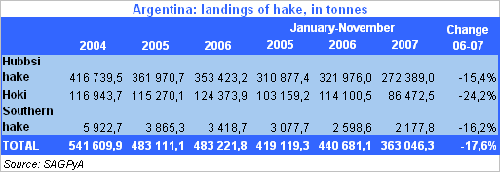
Hubbsi hake is going through a period of weaker supplies. Last year the TAC was reduced by about 10% as previously mentioned, and in 2007 the outlook is that, again, as in 2006, captures will not meet with the maximum allowed level (340 000 tonnes). While the TAC for 2008 has not been published yet, a strong reduction is expected, between 10% and 15%, which would set the quota at about 275 000 tonnes. Also additional conservation measures, such as stricter controls on ships, are being proposed by the government of one of the provinces. These measures are similar to those applied on shrimp stocks which were evaluated as successful, given the strong current supplies. The special attention currently focused on hake stocks is reflected in several changes in the fishing ban areas.
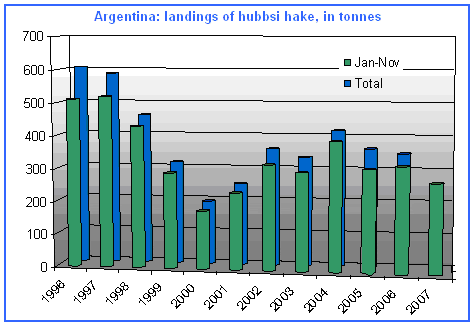
Another subject that concerns ship owners in particular but also plants processing hake, is the increase in operational costs. Provincial governments are analyzing possible measures in order to minimize the impact of the crisis of the resource on the sector, given that a lower capture quota is imminent. Some operators are already demanding a reduction on export duties. Also in some processing plants, layoffs have already started due to the shortage of raw material, while other plants in collaboration with unions were trying to deal with the issue of laid-off workers. This situation generates more concern in a productive sector that has been suffering an increase of operational costs on a resource that is actually going through a crisis.
Exports
Argentinean exports of hake between January and October 2007 fell both in terms of volume and value compared to the same period in 2006 (-23% and -5.2%). The stronger decline in volumes implied a significant increase in export unit values (+23.1%). Exports of hake in the period under review totaled 124 481.8 tonnes worth US$ 279.1 millions. The main exported species, as usual, is hubbsi hake, accounting for 85.5% of total exports (106 441 tonnes), followed by hoki with a 13.2% share in the exported volume. There was a reduction in volumes for all species while export unit values for the various species increased with the value of hubbsi exports actually increasing for the period.
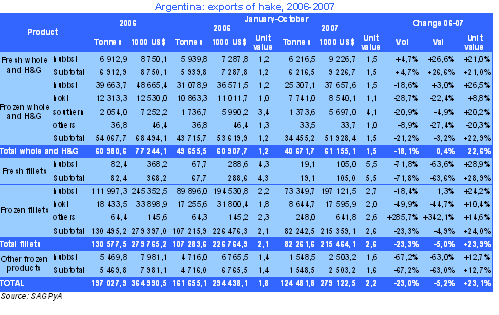
One of the more positive export results was evident in the fresh whole and H&G category, which grew both in terms of volume and value (+4.7% and +26.6%) reaching 6 216.5 tonnes worth US$ 9.2 million. This was the only product category which saw an increase in sales both in terms of volume and value. Regional trade is extremely important in this product, given that 90.9% of total volumes are sold to Uruguay. This country in the same period of 2006 accounted for 74.7% of sales of this product. The remaining destinations for this line of production are European markets.
The main exported category in the first ten months of 2007 was frozen fillets. However, the variation of sales to foreign markets was negative both in terms of volume and value (-23.3% and -5% respectively). This is the main presentation for hubbsi products, 69% of exports of this species are in frozen fillet form, and hubbsi accounts for 89% of total frozen fillets sales. The average unit value for frozen hake fillets grew by 24%, and after fresh fillet export unit values (which grew 28.9%), it showed the best performance in this variable compared to the other products. 28.8% of sales of frozen fillets are destined to Brazil (21 144 tonnes), followed by Spain (11.3%), the US (10.1%) and Italy (10%). It is worth highlighting that the Brazilian share of frozen fillet exports grew from 24.3% between January and October 2006 to the previously mentioned 28.8% for the same period in 2007.
The general trend for unit values was upwards, which is not surprising given the low level of captures. The average increase in export unit values was 23.1%. The highest unit value was registered by sales of fresh fillets of hubbsi hake to Spain (US$ 6.44/kg), which in 2007 was the only buyer of this product. The second best unit price (always in average terms) was reached by frozen deepskinned hubbsi fillets (U$S 5.56/kg), and 78% of sales of this line of production is destined for Italy.

The main destination for exports of hake is Brazil which accounts for 17.6% of total volumes and 19.2% of values (21 956 tonnes worth US$ 53.6 million). Second comes Spain with 19 828 tonnes worth US$ 43.4 million, followed, with a much lower share, by the US (8 163.5 tonnes; US$ 20.8 million), Italy (8 109.7 tonnes; US$ 26.8 million), Germany (7 841.5 tonnes; US$ 18.5 million) and Uruguay (5 807.6 tonnes; US$ 7.8 million). These countries together account for 58% of total sales of hake from Argentina to foreign markets.
Outlook
Perspectives for hake in Argentina in 2008 are not very promising. The species is going through a crisis, with a reduction in stocks and captures. A significant cut in the TAC is expected, as well as additional measures for protection and management. However, according to some officials, there is a relatively good level of juvenile specimens which, if good management measures are taken, can be exploited in 2009. On the other hand, ship owners are facing, as in most capture activities, an increase in operational costs, for trips that are lasting more days. The lack of raw material has an impact on processing plants, and measures from the government to reduce the impact of the lower level of activity are demanded by operators.
Chile
Landings
Landings of hake in Chile between January and November were 102 029 tonnes, 4.5% lower than in the same period in 2006, when total landings were 106 847 tonnes. The most captured species is hoki (Macruronus magellaniucus) with a 38.4% share, followed by common hake (Merluccius gayi) with a 37.7% share and southern hake (Merluccius australis) with a 23.9% share. The latter species is the only one in the period under review which had an increase in captures (+2.4%).
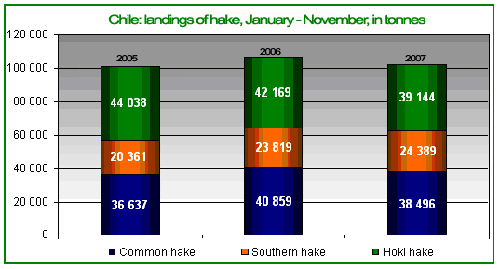
Captures of hake have been suffering systematic reductions, and the resource is evaluated as being currently in crisis. This has affected negatively an important number of workers and operators, especially in the artisanal sector which has hake as one of the most important resources. However, recent captures have shown some signs of improvement. For 2008, the Fishing Subsecretary plans to adopt new resource management measures, as well as the introduction or extension of moratoriums to protect the resource. In addition, the Fishing Subsecretary, set the TAC for 2008. For common hake, the quota is lower than in previous years, but it is expected that the lower maximum can be effectively fulfilled. The TAC for hake in 2008 can be observed in the chart below:
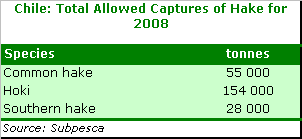
Exports
Chilean exports of hake between January and September registered 41 015.2 tonnes worth US$ 120.4 million. This represents a 13.6% reduction in terms of volume and a 2.6% increase in terms of value compared to the 47 473.6 tonnes worth US$ 117.3 million registered in the same period in 2006. The main exported species is southern hake, which with 15 282.7 tonnes, worth US$ 64.9 million, accounts for 39.1% of the exported volume and 55.4% of the exported value in 2007. This represents a 14.1% and 13.2% increase respectively in this species’ share in exports compared to 2006, when the share of southern hake was 34.3% and 48.9% of the exported quantity and value respectively. Common hake also increased its share both in terms of volume and value (+12.3% and +9.4%), and in 2007 it had a 23% and 17.2% share of total exports of hake. As a consequence of the growth in the previously mentioned species, hoki showed a negative variation in its share in exports (-16.2% and -22.3% in quantity and value respectively), resulting in a share in the exported volume and value of 37.9% and 27.5% respectively.
Regarding the unit value of exports, all species experienced the positive trend registered for total exports. The unit value of exports of southern hake grew 18.5%, followed by common hake with a 15.6% growth, and for hoki the variation was +10%. All these variations contributed to the overall result of an 18.7% increase in the total export unit value.

In terms of quantity, the most exported product category was frozen fillets, with 13 498 tonnes (-1.3% compared with the same period in 2006), accounting for 34.5% of total exports. In terms of value, this product was placed second, with US$ 34.2 million (+9.5% and 29.4% of total exported value). The most important species in the fillet category was hoki, accounting for 57.2% of the exported volume of frozen fillets. The highest export unit value was registered for frozen fillets of southern hake (US$ 6.8/kg). In terms of value, the main product was frozen whole and H&G hake. This line of production produced sales to foreign markets, between January and September, 2007 of US$ 36.9 million (+10.8% and 31.5% of total exported value). In terms of quantity, this product category was in second position, with 10 043 tonnes (-18% and 31.5% of total exported volumes). The average unit value of these products showed the strongest increase among frozen products, +35%.
The main destination for Chilean exports of hake was Spain. This country was the destination for 39.2% of total volumes, and sales to this country accounted for 52.9% of sales of hake to foreign markets. 92% of the volumes sold to Spain are southern hake products. The second main buyer of Chilean hake products was the US market, but with a much lower share (13.4% and 10.2% in terms of volume and value), 74.8% of sales to the US are frozen common hake products. Third comes Japan (8% and 6.3% in terms of volume and value respectively), followed by Poland (7% and 5.3%). Sales to both of these countries are mainly of hoki, 95.5% and 96.9% of the volumes traded with these countries respectively.
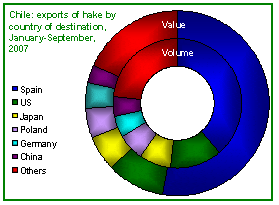
Outlook
Chilean exports of hake are showing an upward trend in unit values which contrasts with the fall in exported volumes. Probably exports for the whole of 2007 will not meet the level reached in 2006 (60 093 tonnes), given the shortage of raw material. However, some operators and officials are optimistic regarding the state of the resource which might be showing some signs of recovery. Nevertheless, the concern remains, as this resource has a strong impact on employment in several communities which the strong decline in hake landings hit strongly in 2004.
Uruguay
Landings
Captures of hake in Uruguay between January and October were 5.9% lower than in the same period in 2006. This fall is probably partly due to the strike of workers in the fishing sector. Captures of hake have been decreasing over the past year, a trend that was also shown in Argentina. It is worth noting that Uruguay and Argentina share fishing areas, and in the common fishing area currently there is a ban on hake fishing in effect. The main capture species is hubbsi hake, accounting for 98.6% of total captures in 2007. The other species captured is hoki which registered an important fall in captures between 2006 and 2007 for the period under review (-67%).

Exports
Uruguayan exports of hake showed the same trend that was described for the previously analyzed countries, a reduction in the exported volumes, -15.3% to 19 235 tonnes, and an upward trend in unit values. Increases in average unit values were not strong and the value of exports also decreased, -13.6% to US$51.7 million. The most exported product category is frozen fillets, which account for 61.9% of total exported volumes and 76.3% of the exported value in the period under review. Sales of this line of products were 21.2% lower in quantity than in the same period in 2006. The main buyers of frozen fillets of hake from Uruguay in the period under review were Italy (34.8% of the exported volume), Russia (20.9%), Germany (11.4%), Holland (10.6%) and France (9.3%). The share of these markets together in sales of frozen fillets was 87%.
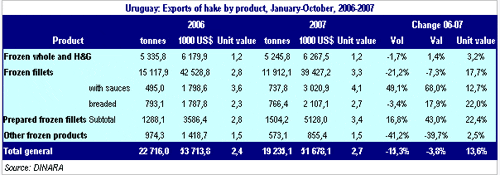
The best performance was shown by frozen fillets with sauces, which had a remarkable growth, both in terms of volume and value, +49.1% and +68% respectively. This line of products, as well as frozen breaded fillets, had the best performance in terms of unit value increases, +12.7% and +22% each. Altogether these value-added products grew 16.8% in terms of volume and 43% in terms of value, resulting in a 22.4% growth in average unit values. The main buyers of these products are European countries. In the case of frozen fillets with sauces, the main buyers are Italy, France, Belgium and Spain, with 44.9%, 21.4%, 17.2% and 15.6% of exported volumes respectively, and altogether account for 99.1% of total sales of frozen fillets with sauces to foreign markets. As for frozen breaded fillets, the main buyers are Italy and Spain which are the destination for 54.8% and 34.5% of exports in quantity.
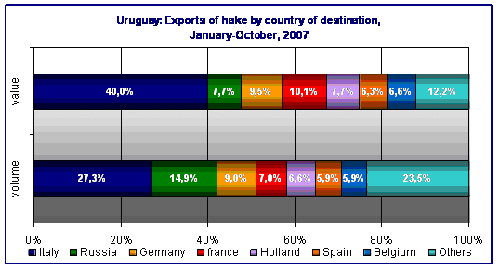
Outlook
Hake is suffering, throughout the region, problems regarding the abundance of the resource. This has a negative impact on the traded volume. However, it is interesting to note that Uruguay has managed to become an important provider of some value added products to the European market, and is also placed as one of the main providers to some markets, such as Italy. As for the other countries, special attention will be paid to the state of the resource, and measures for stock preservation in the common fishing area with Argentina will surely continue.
December 2007

